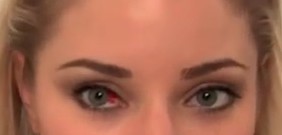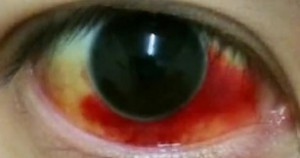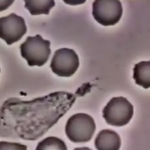At times, small blood vessels in whites of eyes can break and cause some red spots or specks. This condition is referred to as subconjunctival hemorrhage. An individual may not realize that they have broken blood vessel in eye until they look in mirror and see white part of the eye looking bright red. The clear surface of eye also known as conjunctiva cannot absorb blood quickly. Therefore, blood tends to be trapped under that transparent surface.
Although subconjunctival hemorrhage might create worries in people who have it, it is not usually a course for concern because it is harmless and disappears within a few weeks. The condition may occur without apparent or obvious harm to the eye. It may occur as a result of cough or strong sneeze that causes the small blood vessels to break.
You may not need treatment for subconjunctival hemorrhage unless it worsens. The blood may look worrying and alarming if it forms a large spot. The condition is not a serious problem if you do not have other problems such as pain in eye, blood covering large portion of white of eye, vision problem, or blood spreads to the colored part of eye or the iris.
The bleeding occurring between iris and cornea is referred to as hyphema and it is a more serious condition, which may be accompanied by some mild pain, or no pain.
What causes broken blood vessels in the eye?

Though it may not always be easy to identify the cause of subconjunctival hemorrhage, some possible causes associated with the condition are such as eye trauma. When there is an injury that is mild to the eye, it may cause the small vessels to break and release blood that becomes trapped under conjunctiva in the white of an eye or sclera.
When there is a sudden increase in blood, it may cause pressure, which causes the vessels to break. The pressure may be induced by activities such as sneezing, heavy lifting, and coughing or constipation and laughing. Some medicines like blood thinners including aspirin and warfarin may also cause this condition.
A blood clotting disorder may also be associated with broken vessels in eyes. People who have had eye surgery such as cataract surgery may also experience this condition. Conjunctiva is a thin, moist and a transparent membrane which covers that white part of eye known as sclera and the interior of eyelids. It is the outermost coating that offers a protective role to the eyeballs.
The conjunctiva in eyes contains nerves and some small blood vessels. The vessels are not visible but they can enlarge when the eye becomes inflamed thus becoming visible. One thing about these vessels is that they are fragile and they could easily break in their walls causing bleeding under the conjunctiva or subconjunctival hemorrhage. Despite its conspicuous look, subconjunctival hemorrhage is regarded as benign meaning that it causes no vision problems or discomforts.

Symptoms
It takes about 10 or so days for the hemorrhage to disappear. It dissipates on its own often needing no medical treatment. As the hemorrhage dissipates with time, the area may change and appear like a bruise. Besides the bleeding that is visible between the sclera and conjunctiva, subconjunctival hemorrhage may be described as scratchy and itchy feeling on eye surface.
There is no pain exhibited and if any, it is minimal. There is no change in vision though there might be some discomforts. When taken in high amounts, ginger, cayenne, and ginkgo biloba may increase the risk of having broken vessels in the eye. At other times, the vessels of blood in front of eye may break due to an infection such as conjunctivitis and high blood pressure. Crying, rubbing eyes, and vomiting may also cause the vessels to break.
Treatment
In most cases, no treatment is needed for subconjunctival hemorrhage. However, if you experience pain and discomfort, you may need to have the eye checked. Subconjunctival hemorrhage may be seldom dangerous but a more serious condition hyphema can occur in front of the eye between iris and cornea and could be potentially serious presenting severe symptoms.
Because of blood thinning effects of medicines like warfarin and aspirin, they should be avoided. If the cause of subconjunctival hemorrhage is due to injury or trauma, other treatments may be needed to help in healing. If case there is an infection, antibiotics may be administered to treat it.
Typically, the condition should be able to clear up without use of medicines within two or three weeks. If you have any other complications, you should consider seeking medical attention immediately. The doctor may ask you a number of questions such as how long the condition has persisted and the way you have been feeling. Provide precise and accurate information to help the doctor decide on the right treatment.
